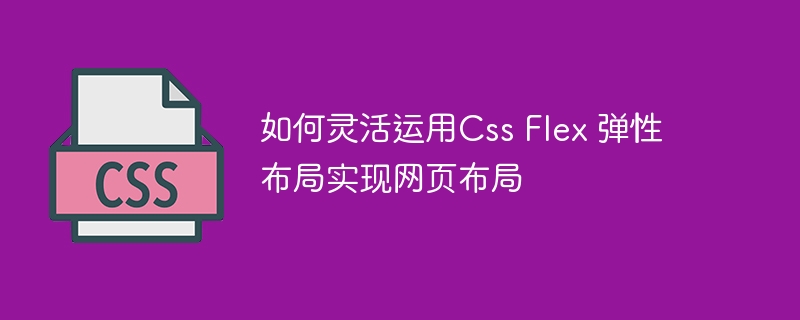

How to flexibly use CSS Flex elastic layout to realize web page layout
CSS Flex elastic layout is a powerful web page layout technology that can help us achieve high flexibility and responsiveness style page layout. This article will introduce how to use CSS Flex elastic layout to implement web page layout, and provide specific code examples.
1. Basic concepts
Before using CSS Flex elastic layout, you need to understand some basic concepts.
2. Usage method
.container {
display: flex;
}.item {
flex: 1; /* 项目的宽度将平均分配,即每个项目占据相同的空间 */
}
.item {
flex: 2; /* 第一个项目占据2份空间,其他项目各占据1份空间 */
}.container {
flex-direction: row; /* 默认值,水平排列 */
}
.container {
flex-direction: column; /* 垂直排列 */
}.container {
justify-content: flex-start; /* 默认值,左对齐 */
}
.container {
justify-content: flex-end; /* 右对齐 */
}
.container {
justify-content: center; /* 居中对齐 */
}
.container {
justify-content: space-between; /* 两端对齐,项目之间的间距相等 */
}
.container {
justify-content: space-around; /* 项目两侧的间距是相邻项间距的一半 */
}.container {
align-items: flex-start; /* 顶部对齐 */
}
.container {
align-items: flex-end; /* 底部对齐 */
}
.container {
align-items: center; /* 居中对齐 */
}
.container {
align-items: stretch; /* 默认值,拉伸填充容器 */
}.container {
align-content: flex-start; /* 顶部对齐 */
}
.container {
align-content: flex-end; /* 底部对齐 */
}
.container {
align-content: center; /* 居中对齐 */
}
.container {
align-content: space-between; /* 两端对齐,项目之间的间距相等 */
}
.container {
align-content: space-around; /* 项目两侧的间距是相邻项间距的一半 */
}
.container {
align-content: stretch; /* 默认值,拉伸填充容器 */
}3. Code Example
The following is a simple web page layout example, implemented using CSS Flex elastic layout.
<!DOCTYPE html>
<html>
<head>
<style>
.container {
display: flex;
flex-direction: row;
justify-content: space-between;
align-items: center;
background-color: #f2f2f2;
}
.item {
flex: 1;
text-align: center;
padding: 20px;
background-color: #ccc;
}
</style>
</head>
<body>
<div class="container">
<div class="item">Item 1</div>
<div class="item">Item 2</div>
<div class="item">Item 3</div>
</div>
</body>
</html>The above code sets the container to be arranged horizontally, with equal spacing between items, items centered on the cross axis, and a background color of light gray. Each item has the same width and text content is centered inside the item.
Summary:
Using CSS Flex elastic layout can quickly and flexibly implement web page layout. By setting container and item properties, you can control the arrangement and alignment of items on the main and cross axes. At the same time, the width ratio of the item can be adjusted by setting the flex property of the item. The above is a simple example. By flexibly using CSS Flex elastic layout, more complex web page layout can be achieved. Hope this article is helpful to you.
The above is the detailed content of How to flexibly use CSS Flex elastic layout to realize web page layout. For more information, please follow other related articles on the PHP Chinese website!